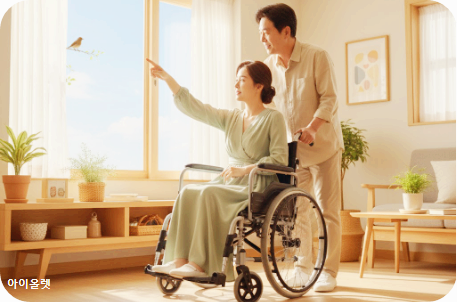루게릭병(ALS, 근위축성 측삭경화증) – 몸이 천천히 멈춰가는 병, 그러나 희망은 멈추지 않는다

한때는 자유롭게 걷고 웃던 사람이, 어느 날부터 손가락 하나 움직이기조차 힘들어진다면 어떤 기분일까. **루게릭병(ALS)**은 바로 그런 잔혹한 현실을 만들어내는 병이다. 신체는 점점 굳어가지만, 의식과 감정은 끝까지 선명하게 남는다. 그래서 더 고통스럽고, 더 두려운 병이다. 그러나 이 병은 ‘끝’이 아니라 ‘함께 싸워야 할 현실’이다.
오늘 주제에 맞는 성경 말씀
“내 은혜가 네게 족하도다 이는 내 능력이 약한 데서 온전하여짐이라.” – 고린도후서 12:9
약함 속에서 오히려 하나님의 능력이 드러난다는 이 말씀은, 루게릭병과 싸우는 사람들에게 위로와 힘이 된다. 인간의 한계를 마주할 때, 믿음은 포기 대신 견딤을 선택하게 한다.
승리 후 찾아온 패배 – 아마샤의 교만과 몰락
승리 후 찾아온 패배 – 아마샤의 교만과 몰락 -역대하 25:14-28인생의 승리는 달콤하지만, 그 끝에는 종종 교만이라는 함정이 도사립니다.유다 왕 아마샤는 전쟁에서 승리했지만, 그 승리가 오히
iallnet12.tistory.com
1. 루게릭병이란 무엇인가
루게릭병(ALS, Amyotrophic Lateral Sclerosis)은 운동신경세포가 서서히 파괴되는 진행성 신경 퇴행성 질환이다. 뇌와 척수에 있는 운동신경이 손상되면서 근육이 점차 약해지고 위축되며, 결국 호흡근마저 마비되어 사망에 이르게 된다.
이 병의 이름은 미국의 전설적 야구선수 루 게릭(Lou Gehrig)이 1939년에 진단받으면서 널리 알려졌다. 한국에서는 ‘근위축성 측삭경화증’으로 불린다.
현재까지 완치법은 없다. 그러나 약물 치료와 재활, 호흡 보조 장치 등으로 진행을 늦추고 삶의 질을 향상시키는 것은 가능하다.
2. 주요 전조 증상
루게릭병의 초기 증상은 매우 미묘해 놓치기 쉽다. 다음과 같은 징후가 반복된다면 반드시 전문의의 진료가 필요하다.

- 근육 약화와 경련 – 손이나 팔, 다리에 힘이 빠지고 물건을 자주 떨어뜨린다.
- 말하기·삼키기 어려움 – 혀가 둔해지고 발음이 뭉개지며, 침을 자주 흘리거나 음식 삼키기가 힘들다.
- 근육 경직 및 경련성 움직임(경련성 위축) – 밤에 쥐가 자주 나거나 팔·다리가 떨린다.
- 호흡곤란 – 병이 진행되면 호흡근이 약해져 숨쉬기 어려워지고 수면 시 무호흡이 나타난다.
- 인지 기능 변화 – 일부 환자는 감정 조절이 어렵거나, 성격이 변하는 전두측두엽 치매형 ALS가 나타나기도 한다.
3. 원인과 발병 요인
루게릭병의 정확한 원인은 아직 완전히 밝혀지지 않았다. 그러나 연구에 따르면 다음과 같은 요인들이 관련되어 있다.
- 유전적 요인: 전체 환자의 약 5~10%는 유전성으로, SOD1, C9orf72 등 특정 유전자 돌연변이와 관련된다.
- 산화 스트레스와 단백질 변형: 신경세포 내 단백질이 변형되거나 쌓이면서 세포가 손상된다.
- 면역 이상: 염증 반응이 과도하게 일어나 신경세포가 파괴된다.
- 환경 요인: 중금속, 살충제, 군복무 중 노출된 화학물질 등이 일부 연관된 것으로 보고된다.
4. 진단 과정
루게릭병은 특정한 단일 검사로 진단하기 어렵다. 대신 여러 검사를 통해 다른 질환을 배제하며 진단한다.
- 근전도 검사(EMG): 근육의 전기적 활동을 측정해 신경 손상 여부를 확인.
- MRI(자기공명영상): 뇌·척수 이상 여부를 확인해 다른 원인 질환을 배제.
- 혈액 및 유전자 검사: 염증 수치나 유전 변이를 조사.
이러한 검사를 종합해 의사가 판단하며, 조기 진단이 빠를수록 치료와 관리의 폭이 넓어진다.
5. 치료와 관리 방법
루게릭병의 치료는 진행을 늦추고 삶의 질을 유지하는 것에 초점을 맞춘다.

- 약물치료: 리루졸(Riluzole), 에다라본(Edaravone) 등은 신경세포 손상을 늦추는 데 도움을 준다.
- 호흡 관리: 비침습적 인공호흡기나 산소치료로 호흡근 마비에 대응한다.
- 재활 치료: 물리·작업·언어치료로 근육 기능을 최대한 유지하고, 삼킴·발음 능력을 보조한다.
- 영양 관리: 삼킴곤란이 심할 경우 위루관(Gastrostomy tube)으로 영양을 공급한다.
- 심리·가정 지원: 환자와 가족 모두 정신적 소진이 크므로 상담과 지원 프로그램이 필수적이다.
6. 일상 속 예방법과 조기 대응
루게릭병은 완전한 예방이 어렵지만, 조기 발견과 신경세포 보호 습관으로 위험을 줄일 수 있다.

- 규칙적인 운동과 균형 잡힌 식단: 항산화 성분(베리류, 녹황색 채소, 견과류)이 신경세포 보호에 도움.
- 중금속·화학물질 노출 최소화
- 스트레스 관리와 수면 유지: 만성 피로는 신경 기능을 약화시킨다.
- 가족력 있는 경우 정기 신경검진

7. 마무리 – 절망이 아닌 연대의 병
루게릭병은 몸을 묶지만, 마음까지 묶을 수는 없다. 병의 진행을 늦추는 것은 의학뿐 아니라 사랑과 지지, 그리고 포기하지 않는 태도다.
루게릭병은 희귀하지만, 더 이상 ‘남의 이야기’가 아니다. 조기 발견과 꾸준한 관리가 희망의 끈을 이어준다.
칼만 종양 – 인슐린 과다 분비로 인한 저혈당의 함정, 췌장의 희귀암 경고
암 예방 시리즈 ㉚ 칼만 종양 – 인슐린 과다 분비로 인한 저혈당의 함정, 췌장의 희귀암 경고몸이 이유 없이 떨리고 식은땀이 나며, 손끝이 저린 경험이 있는가? 단순한 피로나 스트레스의 신호
iallnet.com
다음 편 예고
다음 편에서는 “샤르코-마리-투스병(CMT)”, 즉 말초신경 손상으로 근육이 서서히 약해지는 또 다른 희귀질환에 대해 알아본다. 루게릭병과는 다른 메커니즘이지만, 공통된 교훈은 ‘조기 인식과 지속적 관리’다.
출처
보건복지부 희귀질환센터, 국립중앙의료원 신경과, 대한신경과학회, 미국 ALS Association, NIH Rare Disease Database
◆ View the English translation. Click below.
Amyotrophic Lateral Sclerosis (ALS) – A Body That Slows, But Hope That Never Stops
Imagine one day you can walk freely and smile, and the next, even lifting a finger becomes impossible. ALS (Amyotrophic Lateral Sclerosis) is that cruel reality. The body slowly stiffens, yet the mind stays fully awake. It is a battle of willpower against the silent collapse of the body. But this illness does not mean the end—it means the beginning of a shared fight for life.
Bible Verse of the Day
“My grace is sufficient for you, for my power is made perfect in weakness.” – 2 Corinthians 12:9
Even in the face of weakness, God’s strength becomes complete. For those living with ALS, this verse reminds them that perseverance and faith can coexist with pain.
1. What Is ALS?
ALS is a progressive neurodegenerative disease in which motor neurons in the brain and spinal cord deteriorate, leading to muscle weakness, atrophy, and ultimately respiratory failure.
Named after baseball legend Lou Gehrig, the disease remains without a cure. However, medications, rehabilitation, and assistive breathing devices can slow its progression and improve quality of life.
2. Early Warning Signs
The onset is subtle and easy to miss. Key early symptoms include:
- Muscle weakness and cramps – Frequently dropping objects or losing grip.
- Speech and swallowing difficulties – Slurred speech, drooling, or choking on food.
- Muscle stiffness and twitching – Night cramps or involuntary jerking.
- Shortness of breath – Weakening of respiratory muscles, sometimes leading to sleep apnea.
- Emotional or cognitive change – Some patients develop frontotemporal dementia with emotional instability.
3. Causes and Risk Factors
The exact cause is unknown, but research identifies several contributors:
- Genetic factors: About 5–10% of cases are hereditary, linked to mutations in genes such as SOD1 and C9orf72.
- Oxidative stress and protein misfolding: Damaged proteins accumulate and kill nerve cells.
- Immune dysfunction: Excessive inflammation may accelerate neuron death.
- Environmental exposure: Heavy metals, pesticides, or toxins may increase risk.
4. Diagnosis
There is no single definitive test for ALS. Diagnosis requires excluding other diseases through:
- Electromyography (EMG)
- MRI scans
- Blood and genetic tests
Early diagnosis expands treatment options and helps maintain function longer.
5. Treatment and Management
The main goal is to slow progression and preserve life quality.
- Medications: Riluzole and Edaravone slow neuronal damage.
- Respiratory care: Non-invasive ventilators and oxygen support.
- Rehabilitation: Physical, occupational, and speech therapy.
- Nutritional support: Gastrostomy feeding when swallowing becomes difficult.
- Psychological and family support: Counseling is essential for both patients and caregivers.
6. Prevention and Early Care
While prevention is difficult, certain habits may protect neurons:
- Balanced diet rich in antioxidants
- Avoid heavy metal and chemical exposure
- Manage stress and sleep well
- Regular neurological checkups for those with family history
7. Conclusion
ALS may imprison the body but not the spirit. Every day lived with courage is a defiance of the disease itself. Early recognition and compassionate care can transform despair into dignity and hope.
Next Episode Preview
The next topic will explore Charcot–Marie–Tooth Disease (CMT), another rare condition that weakens muscles through peripheral nerve damage.
Sources (English)
Ministry of Health and Welfare (Korea), National Medical Center, Korean Neurological Association, ALS Association (USA), NIH Rare Disease Database
#ALS, #AmyotrophicLateralSclerosis, #LouGehrigDisease, #MotorNeuron, #Neurodegeneration, #Riluzole, #Edaravone, #MuscleAtrophy, #RareDisease, #NeuralHealth
끝까지 읽어 주셔서 감사합니다.
◆ 제 다른 글 소개
예능계의 ‘브랜드 송가인’… 시청률 상승 엔진
송가인, 나왔다 하면 시청률 급상승…“예능 치트키”의 힘 최근 방송가에서 가장 뜨거운 이름 중 하나가 ...
blog.naver.com
배우 김영옥, 친한 동창에게 당한 돈거래 거부 선언
김영옥 “친한 친구에게 사기당해 전 재산 잃었다”… 삶이 가르쳐준 인간관계의 진실 배우 김영옥은 수십 ...
blog.naver.com
'건강정보 > 신체건강' 카테고리의 다른 글
| 유전자가 빚어내는 잔혹한 춤, 마음과 몸을 무너뜨리는 질병의 실체 (7) | 2025.10.18 |
|---|---|
| 샤르코-마리-투스병(CMT) – 신경이 서서히 사라지는 병, 희망은 남아 있다 (4) | 2025.10.16 |
| 칼만 종양 – 인슐린 과다 분비로 인한 저혈당의 함정, 췌장의 희귀암 경고 (2) | 2025.10.14 |
| 여성 호르몬의 균형이 무너질 때 찾아오는 경고 신호 (8) | 2025.10.12 |
| 여성의 침묵 속에 숨어든 작은 징후, 조기 발견이 희망을 만든다 (6) | 2025.10.11 |


